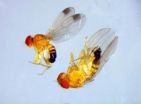(Press-News.org) PITTSBURGH, March 16 – Researchers at the University of Pittsburgh School of Medicine have identified a cell-signaling pathway that plays a key role in increasing insulin secretion during pregnancy and, when blocked, leads to the development of gestational diabetes. Their findings are available online today in Diabetes, one of the journals of the American Diabetes Association.
During pregnancy, pancreatic beta cells should expand and produce more insulin to adapt to the needs of the growing baby, explained senior investigator Adolfo Garcia-Ocana, Ph.D., associate professor of medicine, Division of Endocrinology and Metabolism, Pitt School of Medicine. Newborns can suffer complications if the mother's blood glucose is abnormally high during pregnancy, a condition known as gestational diabetes.
"Not much was known about the maternal mechanisms that lead to increased beta cell number and function during pregnancy," Dr. Garcia-Ocana said. "But research has shown that high blood glucose in pregnancy can have long-term health consequences for the child, as well as a greater risk of hypertension, type 2 diabetes, and high cholesterol for the mother."
His team began studying a protein called hepatocyte growth factor (HGF), which was discovered by George K. Michalopoulos, M.D., Ph.D., professor and chair, Department of Pathology, Pitt School of Medicine, in 1990. Blood levels of HGF are markedly increased in pregnancy. The protein interacts with a cell surface receptor called c-MET.
The researchers engineered mice that lacked the c-MET receptor in pancreatic cells and found that their beta cells functioned correctly, keeping blood glucose within normal parameters in adult mice. But when the mice got pregnant, they took on the features of gestational diabetes.
"Mice that didn't have the c-MET receptor in their pancreas had lower plasma insulin levels, higher blood glucose and impaired ability to regulate glucose levels," Dr. Garcia-Ocana said. "Without the receptor, they couldn't respond to HGF." Also, unlike normal healthy pregnant females, these mice didn't produce more beta cells, had more beta cell death and so had reduced beta cell mass.
"These findings provide the first direct evidence that HGF/C-MET signaling pathway has an important role in maternal beta cell adaptation during pregnancy," Dr. Garcia-Ocana noted. "Perhaps women who have a variation in the HGF gene or in the c-MET receptor are predisposed to developing gestational diabetes because they cannot adequately compensate for the increased insulin demands of pregnancy."
In future work, he and his team will explore HGF signaling in pregnant women, which could one day provide a new means of diagnosing, treating or preventing gestational diabetes.
###
Co-authors include Cem Demirci, M.D., of the Department of Pediatrics, Pitt School of Medicine; and Sara Ernst, Ph.D., Juan C. Alvarez-Perez, Ph.D., Taylor Rosa, B.S., Shelley Valle, B.S.,Varsha Shridhar, Ph.D., Gabriella P. Casinelli, B.S., Laura C. Alonso, M.D., and Rupangi C. Vasavada, Ph.D., all of the Division of Endocrinology, Pitt School of Medicine.
The project was funded by grants DK067351, DK077096, DK072264, and T32DK07052-32 from the National Institutes of Health, as well as the American Diabetes Association and the Lawson Wilkins Pediatric Endocrine Society.
About the University of Pittsburgh School of Medicine
As one of the nation's leading academic centers for biomedical research, the University of Pittsburgh School of Medicine integrates advanced technology with basic science across a broad range of disciplines in a continuous quest to harness the power of new knowledge and improve the human condition. Driven mainly by the School of Medicine and its affiliates, Pitt has ranked among the top 10 recipients of funding from the National Institutes of Health since 1997.
Likewise, the School of Medicine is equally committed to advancing the quality and strength of its medical and graduate education programs, for which it is recognized as an innovative leader, and to training highly skilled, compassionate clinicians and creative scientists well-equipped to engage in world-class research. The School of Medicine is the academic partner of UPMC, which has collaborated with the University to raise the standard of medical excellence in Pittsburgh and to position health care as a driving force behind the region's economy. For more information about the School of Medicine, see www.medschool.pitt.edu.
http://www.upmc.com/mediarelations
END
CHICAGO – In a study that included a nationally representative sample of nearly 45,000 adults, participants who met more of seven recommended cardiovascular health behaviors or factors (such as not smoking, having normal cholesterol levels, eating a healthy diet), had a lower risk of death compared to participants who met fewer factors, although only a low percentage of adults met all seven factors, according to a study appearing in JAMA. The study is being published early online to coincide with its presentation at a specialty meeting of the American Heart Association.
"Cardiovascular ...
The northeastern U.S. should prepare for a surge in Lyme disease this spring. And we can blame fluctuations in acorns and mouse populations, not the mild winter. So reports Dr. Richard S. Ostfeld, a disease ecologist at the Cary Institute of Ecosystem Studies in Millbrook, NY.
What do acorns have to do with illness? Acorn crops vary from year-to-year, with boom-and-bust cycles influencing the winter survival and breeding success of white-footed mice. These small mammals pack a one-two punch: they are preferred hosts for black-legged ticks and they are very effective ...
Nanoparticles containing chitosan have been shown to have effective antimicrobial activity against Staphylococcus saprophyticus and Escherichia coli. The materials could be used as a protective wound-healing material to avoid opportunistic infection as well as working to facilitate wound healing.
Chitosan is a natural, non-toxic and biodegradable, polysaccharide readily obtained from chitin, the main component of the shells of shrimp, lobster and the beak of the octopus and squid. Its antimicrobial activity is well known and has been exploited in dentistry to prevent ...
New biotechnological and chemical methods will facilitate efficient production of chemicals, materials and fuels from renewable natural resources. The Academy of Finland Centre of Excellence (CoE) in White Biotechnology – Green Chemistry Research focuses on the research and development of microbial cells, or cell factories, for producing new useful compounds from sugars in plant biomass. These compounds can be used, for example, for manufacturing bioplastics or in medical applications.
"By means of gene technology, we can modify microbial metabolism and thereby produce ...
Coming from the Asian continent, Drosophila suzukii has only been in Spain for a short time. Far away from slipping through into the Iberian Peninsula, it accelerated towards the north of Europe where it has already crossed the Alps. Amongst its preferred target are cherries and red fruits but any type of fruit is suitable for it to lay its eggs. This insect is posing a threat to the fruit of more and more European countries.
"Out of the 3,000 known species of Drosophilae, commonly named the vinegar fly, only two are potentially dangerous to fruit crops. One of them is ...
Have you ever wondered how life is sustained in environments like deserts, deep seas or the polar regions? How do organisms adapt and thrive in such harsh conditions, and what challenges do they face as a result of human activities and climate change, especially climate "extremization"? Shedding light on some of these issues is the objective of the European Science Foundation's (ESF) session on 27 March at Planet Under Pressure 2012. The session will look at different aspects of life in extreme environments - from knowledge to sustainable exploitation of new resources under ...
Montreal, March 16, 2012 – A clinical study co-led by the Montreal Heart Institute and Innovaderm Research Inc., which was presented today at the annual meeting of the American Academy of Dermatology, shows that a new treatment for psoriasis could be associated with a significant decrease in vascular inflammation, a major risk factor of cardiovascular disease.
Psoriasis is a chronic inflammatory disease of the skin and joints that affects up to 3% of the population. This disease is associated with a greater risk of heart attack (infarction) and stroke. The goal of this ...
Early snowmelt caused by climate change in the Colorado Rocky Mountains snowballs into two chains of events: a decrease in the number of flowers, which, in turn, decreases available nectar. The result is decline in a population of the Mormon Fritillary butterfly, Speyeria mormonia.
Using long-term data on date of snowmelt, butterfly population sizes and flower numbers at the Rocky Mountain Biological Laboratory, Carol Boggs, a biologist at Stanford University, and colleagues uncovered multiple effects of early snowmelt on the growth rate of an insect population.
"Predicting ...
In the wilds of New York City--or as wild as you can get that close to skyscrapers--scientists have found a new leopard frog species.
For years, biologists mistook it for a more widespread variety of leopard frog.
While biologists regularly discover new species in remote rainforests, finding this one in ponds and marshes--sometimes within view of the Statue of Liberty--is a big surprise, said scientists from the University of California, Los Angeles; Rutgers University; the University of California, Davis and the University of Alabama.
"For a new species to go unrecognized ...
You've been feeling under the weather. You Google your symptoms. A half-hour later, you're convinced it's nothing serious—or afraid you have cancer. More than 60 percent of Americans get their health information online, and a majority of those decide whether to see a doctor based on what they find. "Wow, this is an era of self-diagnosis," thought Arizona State University psychologist Virginia Kwan, learning that statistic. How might information accessed online affect individual health decisions?
In a new study, Kwan and her colleagues found that the way information is ...



